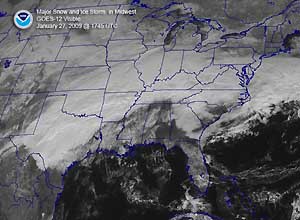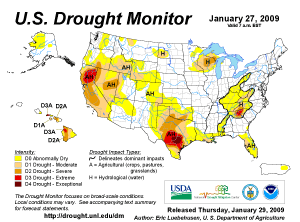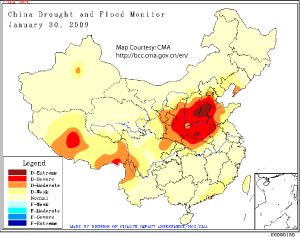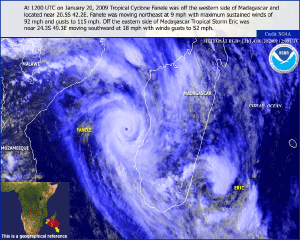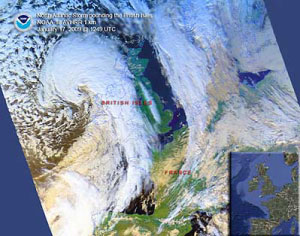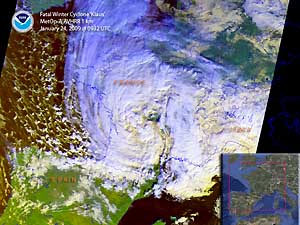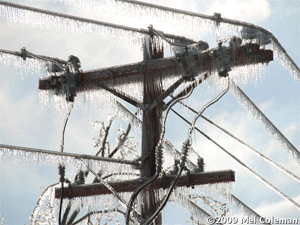
Global Hazards and Significant Events
January 2009
A major ice storm wreaked havoc across parts of the United States during January 26-28. Additional information can be found below.

Across the United States, severe to extreme drought was observed across parts of the Hawaiian Islands, the western continental U.S., and parts of Georgia and South Carolina. Meanwhile, severe to exceptional drought conditions were present across southern Texas. As of January 27, 28% of the western U.S., 38% of the South, 6% of the High Plains, 13% of the Southeast, and 21% of the contiguous U.S. were in moderate to exceptional drought, according to the U.S. Drought Monitor.
In China, moderate to severe drought encompassed parts of the east-central region of the country and Tibet. Extreme drought was present across the Hebei, Shanxi, and Henan provinces (Beijing Climate Center).
In Australia, the New Year brought more of the same: excessive heat. Temperatures there remained above normal as an area of high pressure stalled over the Tasman Sea. In southern Australia, temperatures in Adelaide spiked to 45.5°C (114°F), making it the location's hottest day in 70 years. The heat wave in Victoria was expected to be its worst since 1908, and in Melbourne, organizers of the Australian Open tennis tournament enacted an "extreme heat policy" for the first time in history. Two fatalities were reported in Melbourne (BBC News).

Torrential downpours fell during January 1-13 across parts of the Philippines. Flash floods and landslides caused the evacuation of nearly 200,000 people from affected areas, leaving 11 people dead, with eight others missing. Storm surges were responsible for washing away hundreds of homes and capsizing numerous boats (BBC News).
Heavy rain, which commenced in late December and continued until the first week of January caused floods that claimed the lives of five people in central Vietnam, with 10 others missing (Reuters). The floodwaters inundated nearly 5,000 homes and flooded thousands of acres of rice paddies (BBC News).
In Fiji, copious rain fell during January 8-16, causing floods and landslides that forced thousands of people to evacuate their homes. It was reported that in a period of five days, more than 1,044 mm (41 inches) of rain fell over the town of Monasavu on Viti Levu Island. The floods were described as the worst in a generation. Eleven fatalities were reported (Associated Press/BBC News).
In South America, Peru and Brazil saw an unusually heavy start to their wet season (which runs from November to March). Iquitos, the largest city in the Peruvian rainforest, received over 6 inches of rain within a 24-hour period. While heavy rain in Brazil's Sao Paulo helped farmers to increase coffee production, in other areas floods caused widespread damage. In Minas Gerais, flooding was responsible for three fatalities (BBC News).
On January 6-8, a 'Pineapple Express' brought mild temperatures and torrential rain to the Pacific Northwest U.S., melting snowpack from last month's record snowstorms and causing widespread flooding, mudslides, and avalanches across the state of Washington. More than 30,000 people were encouraged to evacuate their homes due to flooding. Roads and railways were severed as highway officials closed a 20-mile stretch of I-5 and Amtrak passenger service out of Seattle was suspended. Several cities, including Tacoma, declared a civil emergency. A number of precipitation records were set, including Seattle where a record 58.2 mm (2.29 inches) of rain fell at Sea-Tac Airport, and Olympia, which received a record 122.4 mm (4.82 inches) of rainfall. The Snoqualmie River at Carnation reached its highest levels since records began in 1932, measuring a height of 61.5 feet (7.5 feet above flood stage) on January 7. The National Weather Service considers the flood event to be among Washington State's most memorable. The cost of damage is estimated at $125 million (Associated Press).
Heavy rain caused flooding across the southeastern U.S. on January 7. One home in Haywood County, NC was destroyed from a landslide. More than 52,000 residents were left without power in the Carolinas. No fatalities were reported (Associated Press).

On January 3, a violent storm broke out across KwaZulu-Natal, South Africa, killing an estimated 18 people, including a family of 4 struck by lightning inside their Ndwendwe home. More than 2,000 households were affected by what residents describe as one of the worst storms in living memory. Damages included uprooted trees, collapsed roofs, and burst water mains. Ndwendwe, Pietermaritzburg, and Dalton were among the hardest hit areas (BBC News).

Tropical Cyclone Eric developed in the southern Indian Ocean, northeast of the Island of Madagascar, on January 18. The cyclone approached the island's east coast on January 19, lashing the island with maximum sustained winds near 65 km/hr (40 mph or 35 knots) and heavy rain. One fatality was blamed on Eric. On January 19, Tropical Cyclone Fanele formed in the Mozambique Channel, quickly intensifying to a Category 3 hurricane with maximum sustained winds near 185 km/hr (115 mph or 100 knots) on January 20. The next day Fanele made landfall on Madagascar's west coast. The storm brought heavy rain and strong winds, causing floods across large areas, damaging homes, and affecting nearly 28,000 people, including eight fatalities (IRIN/Associated Press).
For 2008 basin tropical cyclone statistics, please refer to the following:
Australian Basin
North Indian Ocean Basin
Western North Pacific Basin
South Pacific Basin
South Indian Ocean Basin
Northeast Pacific Ocean Basin
Atlantic Basin

A severe North Atlantic storm produced ferocious winds across the British Isles on January 17. The high winds downed trees, disrupted power supply to nearly 100,000 homes across Ireland, and caused structural damage to buildings. One person was killed in northern Ireland when a tree fell on their car. According to reports, the strongest winds (161 km/hr [100 mph or 87 knots]) were felt across parts of western and northern Ireland, Scotland, and Wales, while the strongest gust (174 km/hr (108 mph or 94 knots]) was reported in Bulmullet, Ireland (BBC News).
On January 24, a severe storm struck southwestern France and northern Spain, wreaking havoc across the region. The storm's vicious winds of up to 190 km/hr (118 mph or 103 knots) (equivalent to a category 3 hurricane) caused a sports hall to collapse in northeastern Spain, killing four children and injuring 16 others (AFP). The strong winds also downed trees, destroyed roofs, caused disruptions of power and phone services, and was responsible for a total of 26 fatalities. According to reports, this was the worst storm to hit southwestern France and northern Spain since a December 1999 storm claimed of 88 lives (Reuters).

Cold temperatures affected much of the United Kingdom during the first week of January. Temperatures plummeted to -9.0°C (14°F) in Farnborough, Hampshire, the lowest temperature since January 1991. Meanwhile Aboyne, Scotland recorded a temperature of -11°C (12°F) on January 5. It was reported that the United Kingdom has been experiencing some of the lowest temperatures in 15 years during the winter of 2008/2009 (BBC News). No fatalities were blamed on the extreme temperatures.
Across parts of Spain, a severe winter storm produced as much as 6-10 cm (2-4 inches) of snow on January 6-7. The heavy snowfall and poor visibility prompted the closure of Madrid's airport during the morning of the 7th and caused disruptions on road and rail transportation (BBC News).
Bitter cold and widespread snowfall gripped countries in northern and eastern Europe at the beginning of January. In Poland, temperatures dipped down to -25°C (-13°F), causing at least 10 deaths. Germany saw its coldest night of the winter on January 6 with a temperature of -28°C (-18°F) recorded in the eastern state of Saxony. For the first time since 1996, Rotterdam port in the Netherlands had to use an icebreaking ship to clear the port's waterways of ice (Associated Press).
In northern Italy, at least 12 deaths were blamed on the cold and snow during a winter storm January 6-8. Schools were closed in many cities, and Milan's Malpensa and Linate airports temporarily closed due to a foot of snow within the city. It was reported that animals in Rome's Il Bioparco zoo were fed special meals of warm barley porridge, croissants, cookies and hot tea to ensure their caloric intake would be sufficient to keep up their body temperature (Associated Press).
France's Cote d'Azur, which is known for its mild climate, experienced a rare snowfall on January 7. In response to the winter weather, authorities stopped all buses and closed highways in Marseilles, urging drivers to stay indoors. Operators of France's electricity grid urged customers in southern and western parts of the country to limit power usage due to expected record demand (Associated Press).
Arctic cold air swept through the midwestern and northeastern United States during mid-January, plummeting temperatures well below freezing in some areas. Numerous low minimum temperature records were broken during January 16 and January 17. According to reports, this was the coldest event across northern Illinois since February 1996. The severe cold temperatures were blamed for seven fatalities (Associated Press).
Frigid arctic air brought sub-zero temperatures to central and eastern Canada mid-January. Some of the coldest temperatures were recorded near Winnipeg, including a low of -36°C (-33°F) with wind chills of -50°C (-58°F) the night of January 13. Regina, Saskatchewan recorded temperatures of -33°C (-27°F) the morning of January 14 with wind chill factors of -43°C (-45°F). This comes after one of the coldest Decembers for Regina in 26 years (BBC News).
In China, ice and snow threatened to halt transportation on roads and railways as millions prepared to travel for the Lunar New Year holiday (which began January 26). Similar conditions paralyzed China in January of 2008 (Associated Press).
A severe ice and snow storm affected areas from the southern Plains to the eastern United States on January 26-28, producing ice accumulations that wreaked havoc across the affected areas. At its height, the winter storm was responsible for causing widespread outages when 1.3 million residents were left without power. The hardest hit state was Kentucky, where the storm knocked out power for 700,000 residents in Kentucky alone, a state record, and claimed 24 lives (by traffic accidents, hypothermia, and carbon monoxide poisoning). Kentucky's governor, Steve Beshear, described it as the biggest natural disaster the state has experienced in modern history. The governor declared a state of emergency for 93 of the state's 120 counties (Associated Press/CNN) and ordered 4,600 National Guard troops to go door to door to check on families in the western part of the state (the worst-hit area) help clear out debris, and distribute food and water. The hazardous weather was blamed for a total of 55 deaths across all the affected states (Associated Press).
For more information on the U.S. Snow and Ice events, please visit the U.S. Snow and Ice Winter 2008/2009 page.
 NOAA's National Centers for Environmental Information
NOAA's National Centers for Environmental Information
